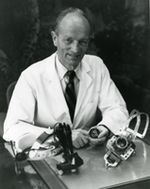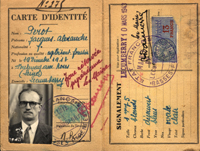 Charles Schepens, MD (1912-2006) was an ophthalmologist practicing in Belgium on May 10, 1940 when Germany invaded his country despite its declaration of neutrality. At the time, Dr. Schepens was also a Belgian reserve air force medical officer. He fought alongside his countrymen for 18 days before Belgium surrendered to the Germans, but Dr. Schepens knew that if given the opportunity he would find a way to aid his country.
Charles Schepens, MD (1912-2006) was an ophthalmologist practicing in Belgium on May 10, 1940 when Germany invaded his country despite its declaration of neutrality. At the time, Dr. Schepens was also a Belgian reserve air force medical officer. He fought alongside his countrymen for 18 days before Belgium surrendered to the Germans, but Dr. Schepens knew that if given the opportunity he would find a way to aid his country.
That chance occurred only a few months later when he was approached to help the Belgian resistance by allowing packages to be delivered and picked up clandestinely at his ophthalmic office. In the spring of 1942, word came that Dr. Schepens' work with the resistance had been discovered. While his wife and children fled to her family in the city of Ghent, Dr. Schepens went over the border into France to avoid arrest.
In Paris, friends of Dr. Schepens helped him to forge a new identity, Jacques Perot-Spengler, and he was able to contact other members of the Belgian resistance in exile. A plan was hatched to purchase a defunct lumber mill in southern France, on the border with Spain, which would be a perfect point to smuggle papers and people out of occupied Europe. This plan was put into effect in June 1942 and Dr. Schepens' family joined him soon afterward.

Dr. Schepens worked to ingratiate himself with the local German forces, making them and the French locals believe he was a collaborator and business man. Unfortunately, on July 21, 1943, the German Gestapo caught up with "Jacques Perot-Spengler" and Dr. Schepens had to run again to evade capture. His wife and children forged their own daring escape across the closely guarded border into Spain and it would be nine months before the family was reunited in England.
During his time as an operative of the Belgian resistance, Dr. Schepens helped dozens of people and countless secret documents cross the border between France and Spain. Dr. Schepens and his family’s miraculous escape from capture, not once but twice, is a testament to their belief in their work against Nazi Germany. After the war, Dr. Schepens moved to the United States and became famous in the ophthalmic community for his work in creating the first binocular, stereoscopic indirect ophthalmoscope (1946) and in treating retinal detachment with an encircling scleral buckle (1953).